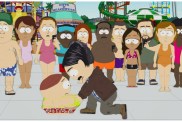
BEYOND THE DOOR II aka SHOCK [1977] (d. Mario Bava, w. Francesco Barbieri, Lamberto Bava, Paolo Brigenti, Dardano Sacchetti)
Ironically, Beyond the Door had little bearing on this sequel. Produced without Assonitis involvement (he was presumably too busy with ripping off Jaws with Tentacles), this retitled effort shares the faintest of connections with the original. David Colin returns, once again in the role of a pint-sized hellraiser; this time, however, he has an excuse, as evil forces lurking within his home have possessed little Marcos soul. Still reeling from the death of her junkie husband seven years earlier, Marcos mother (Daria Nicolodi) has moved back to their old house with a new lover (John Steiner) in towmuch to the dismay of the spirit of her not-so-dearly departed, it would seem.
Having already been unwittingly involved with one schlock-filled Exorcist riff in House of Exorcism (a saga of reediting and repackaging that aptly captures the eras devil-may-care approach to exploitation), Bava subverts expectations with a slow burn haunting, one that returns the director to his more restrained roots after spending much of the decade indulging in savage violence. Perhaps a distant echo of Kill, Baby, Kill (as in that film, one of the most unnerving shots here involves a childs swing), even Shocks original title is a bit misleading since it suppresses much of its graphic violence in favor of an oppressive, melancholy atmosphere.

Far removed from the hysterics expected from possession films, Shock creeps along rather deliberately, if not languidly. Colins Marco is subtly disturbed: where many post-Regan MacNeil creepy kids vulgarly announce their intentions, hes the sort who lies to his mother about chasing a dog when hes actually trying to crash-land his stepfathers plane via voodoo. Overt exploits like this are rare, as the mystery engulfing the family unfolds through Marcos cryptic drawings and his mothers otherworldly dreams. The latter begin to blend into reality when visions of razorblades manifest between piano keys and a particularly sinister piece of art deco furniture reveals its sordid history.
As Shock transitions from possession movie to another exercise in capturing a hysterical womans breakdown, it further embraces nightmare logic. During a climactic sequence that stands out as one of the best in Bavas later oeuvre, his lens distorts reality into a hallucinogenic recollection where fragments of a womans mind are shored against her ruin. Phantasmagoric glimmers of madness become stained with the garish crimson of slashed throats before Bava leaves viewers with a lingering shot of the spectral remains of this family.
Never one to stand pat (he pioneered the giallo and slasher genres but never quite bothered with refining either, for instance), Bava circles back to the gothic overtures of his early work and transports them to a modern milieu that had become an increasingly popular haunt by the 70s. Less The Exorcist and more Bavas take on a suburban ghost story, Shock is interestingly derivative in an unexpected way: audiences were sold a follow-up to Beyond the Door but received something more in the order of Burnt Offerings, right down to the directors willingness to withhold his best jolts until the very end.
Speaking of the end, Shock hails from the twilight of Bavas storied career; his last theatrical feature (and ironically one of the few not to be retooled for its American release), it reveals a maestro that refused to grow content, his penultimate dispatch a haunting little grace note to an incredible career that defied numerous attempts at re-appropriating his work. Its only fitting that one of his last efforts would require him to do one last time.

BEYOND THE DOOR III aka AMOK TRAIN [1989] (d. Jeff Kwitny, w. Sheila Goldberg)
An amusing post-script to the Beyond the Door odyssey, Amok Train is an ironic capper to this non-franchise. When Assonitis set out to produce the film, he had no intentions of connecting it to his previous hit, but distributors eager to capitalize on success foisted one upon him anyway. Suddenly, the man responsible for the likes of Piranha II found himself protesting money-grubbing suits exploiting his work.
Returning alongside Assonitis to finish the trilogy is Satan himself; still looking to claw into the world through a womb, he naturally sets his sights on a group of SoCal students embarking on a trip to Yugoslavia to witness a pagan ritual. Guided by an obviously creepy professor (Bo Svenson) sporting a Satanic goatee (devil cult Bo Svenson is the best Bo Svenson), the teens obliviously wander right into an ambush before realizing the most virginal among them has been chosen as a sacrifice to the dark lord. Sensing no other recourse, the group hops aboard a train that Satan swiftly possesses and renovates into a roving death machine.
Arriving during the last gasp of the Italian horror boom (at which point Bava, Fulci, and Argento had ceded to the latter-day efforts of Claudio Fragrasso, Umberto Lenzi, and Bruno Mattei), Amok Train is a defiant death wail. Though director Kwitny hails from America, his sensibilities are pitched in the instantly recognizable cheeseball sensibilities of late-80s Euro-splatter. By this point, the inherent charm of golden age Italian productionsthe loopy dubbing, the outlandish gore, the curious nightmare logichad been pushed to the edge of knowing camp, if not transformed completely into a new strain of pop-horror looking to meld American splatter with European eccentricity. Any pretense melts away here, completely shorn from the proceedings like so many extremities separated from bodies.

Amok Train follows suit as a rollicking, synth-soaked roadshow of immolations, bisections, and operatic decapitations. With Satan playing conductor, every train car is a Final Destination accident waiting to happen, and the film constantly obliges with one gory showcase after another. Crude effects only add to the insanity, leaving an audience to gawk at phony heads engulfed in flames and a model train hurtling through a plasticine Yugoslavian countryside. It spares little time for them to collect their jaws from the floor since each scene seems hell-bent on topping the last. Another delirious climax awaits, where hooded cultists kneel at the altar of a Satan entombed in ice, waiting to usher in a new age of darkness. Instead, a wild deus ex machina delivers quickly rotting flesh and an unexpected form of divine intervention. Imagine the end of Raiders of the Lost Ark, only the covenant here is a vagina blessed by the Holy Spirit.
Obviously, The Exorcist is firmly in the rear-view here and whether intended or not, Assonitis presides over a film caught in the shadow of his earlier delirium. If Beyond the Door and The Visitor were the ultimate highs of 70s Eurotrash nonsense, then Amok Train is chasing that dragon. It doesnt quite capture it, but, for a few brief moments, it at least grabs it by the tail, slings it around, and tries to offer its severed head in the name of Satan. Maybe it slips away, taking true greatness with it, but Amok Train leaves a messily scrawled pentagram carved in its fleshand in the hearts of anyone who bears witness to its lunatic charms.
—
Brett Gallman is a member of the Online Film Critics Society. He was raised in and around video stores and hasnt stopped talking about horror movies ever since. You can find him on Twitter @brettgallman.








